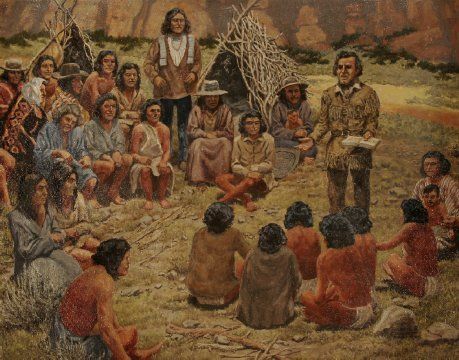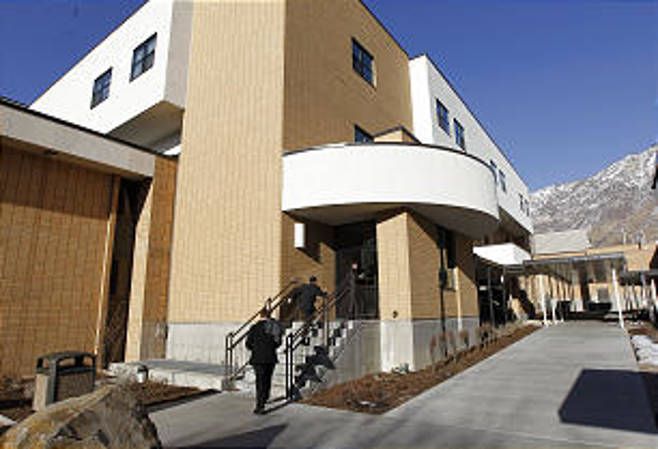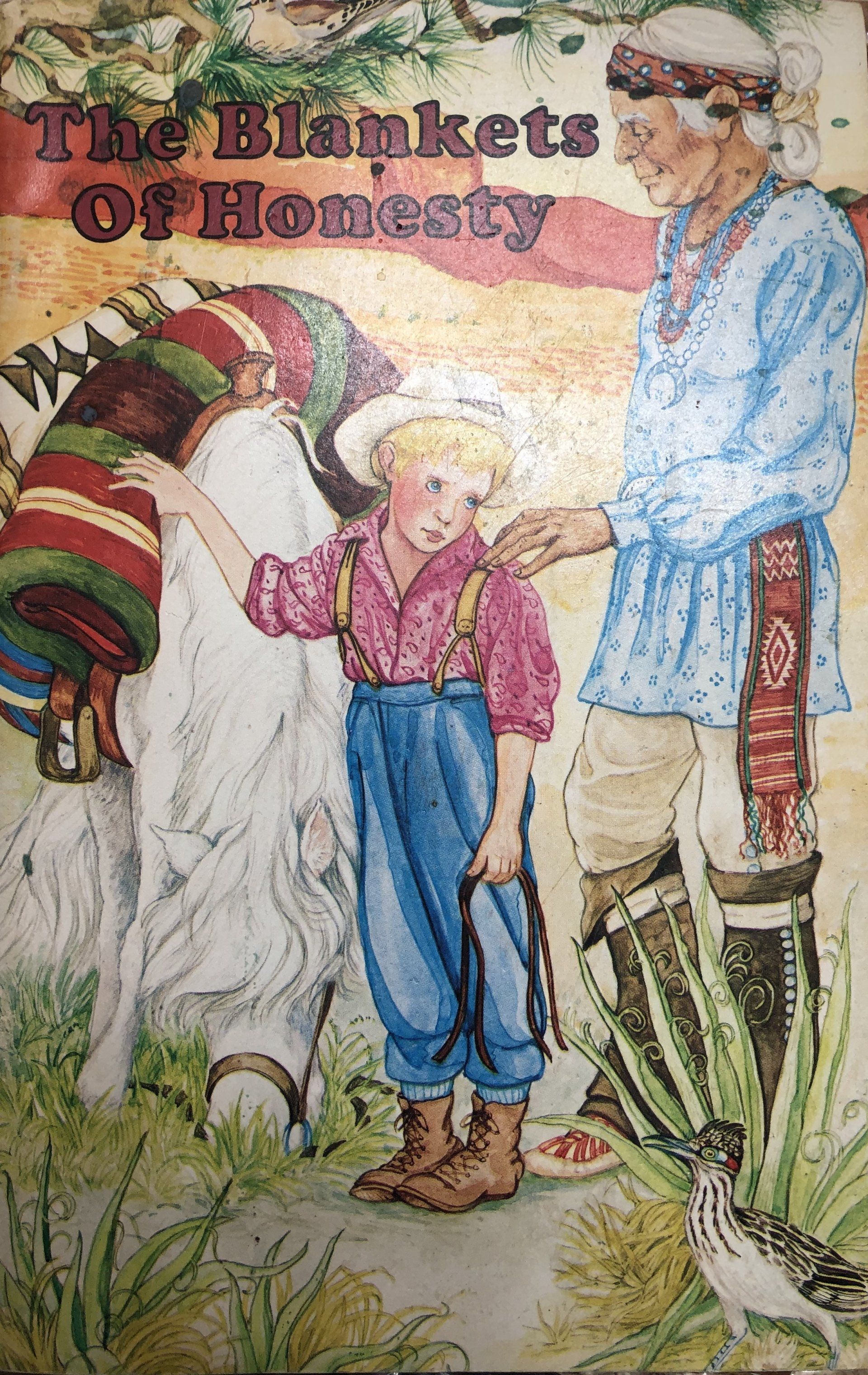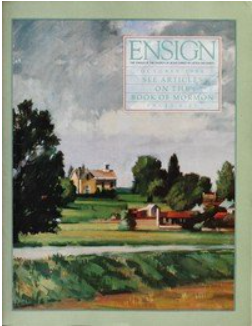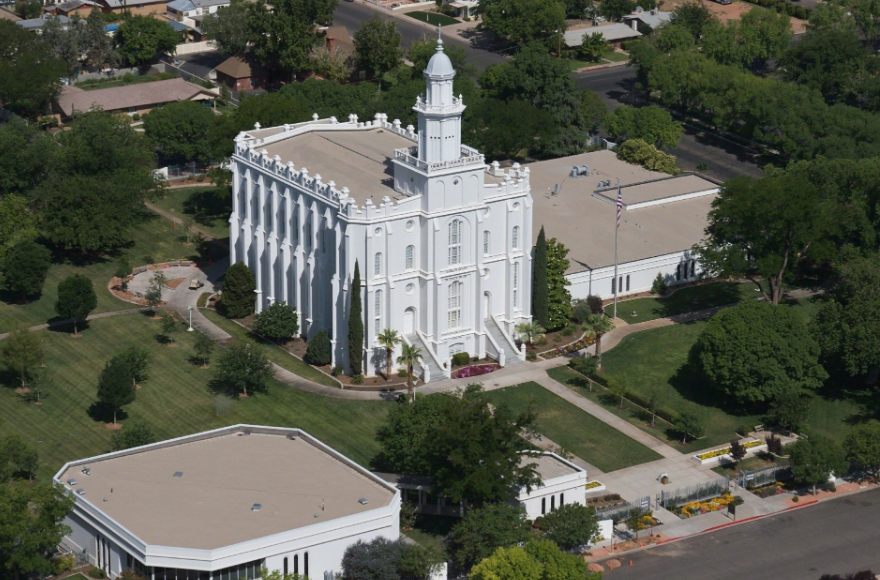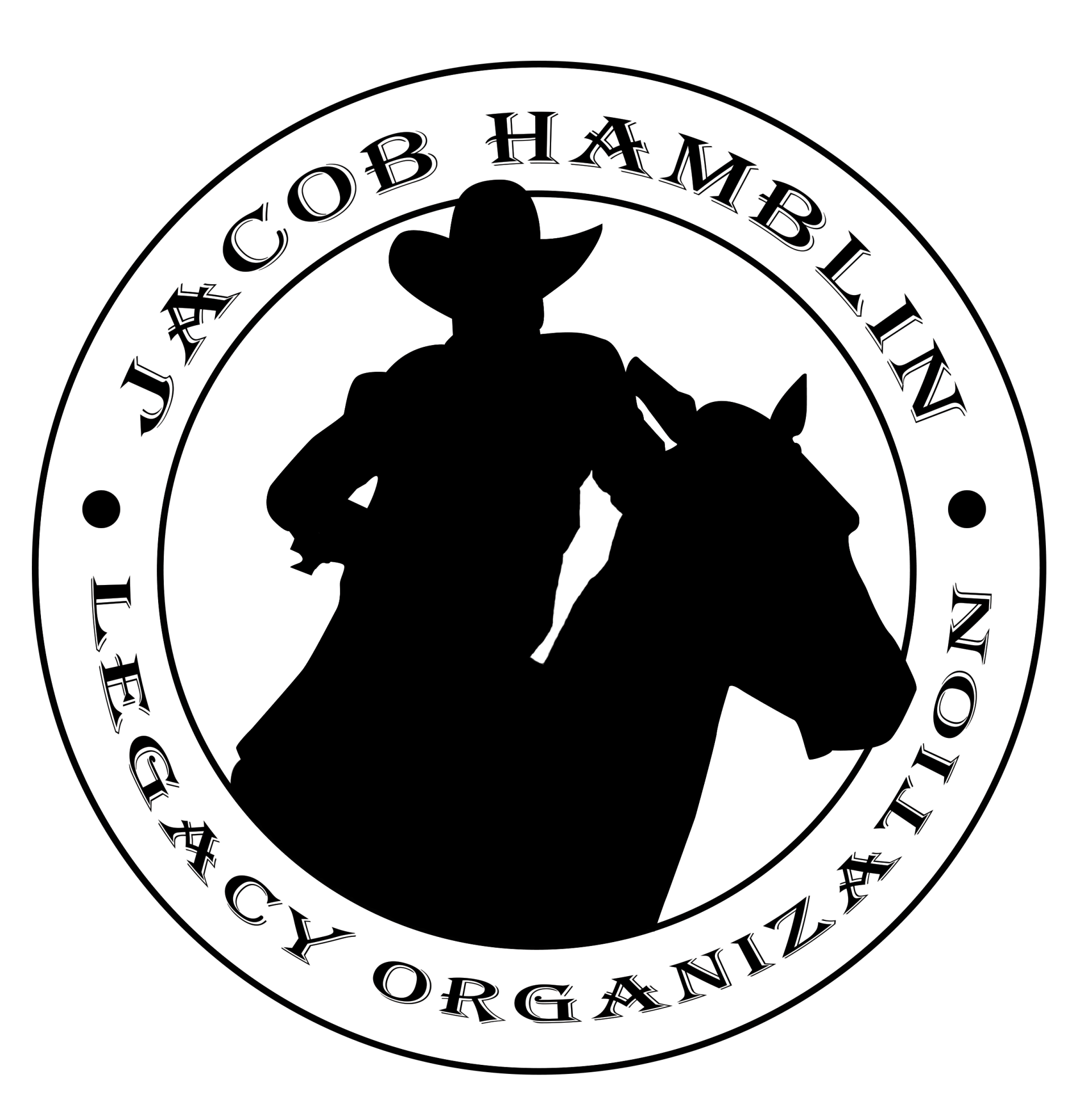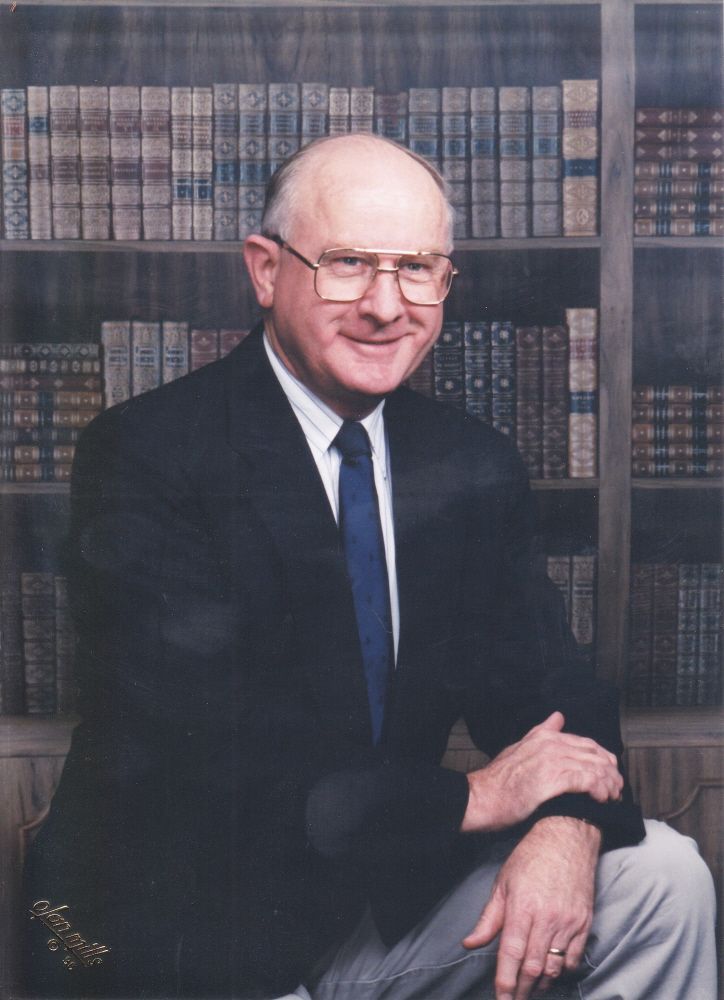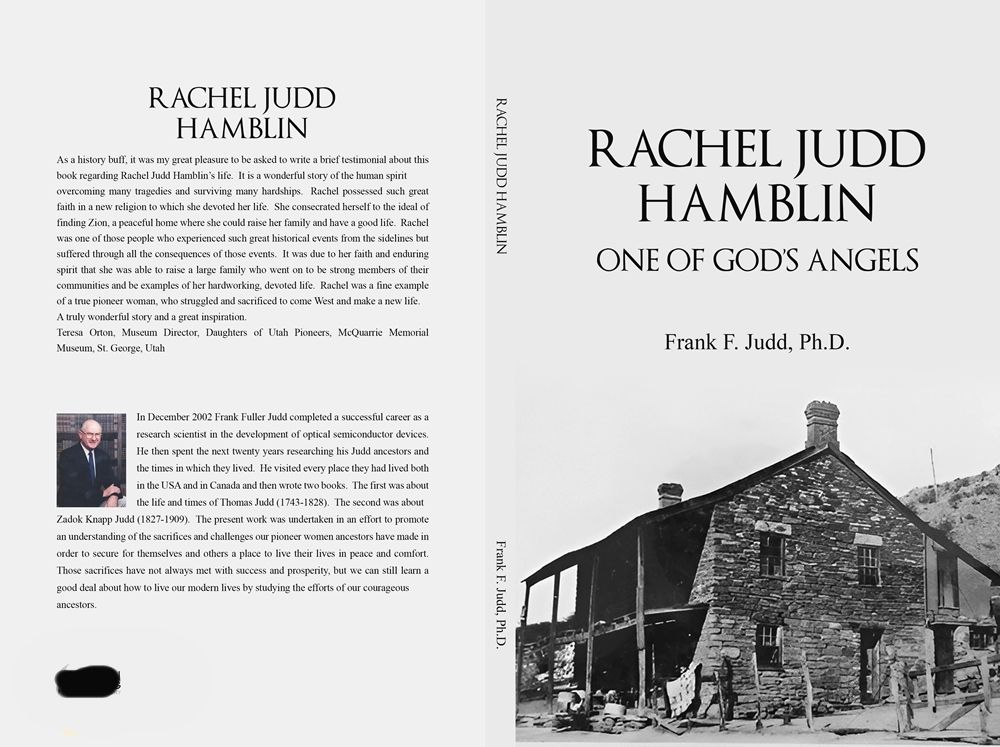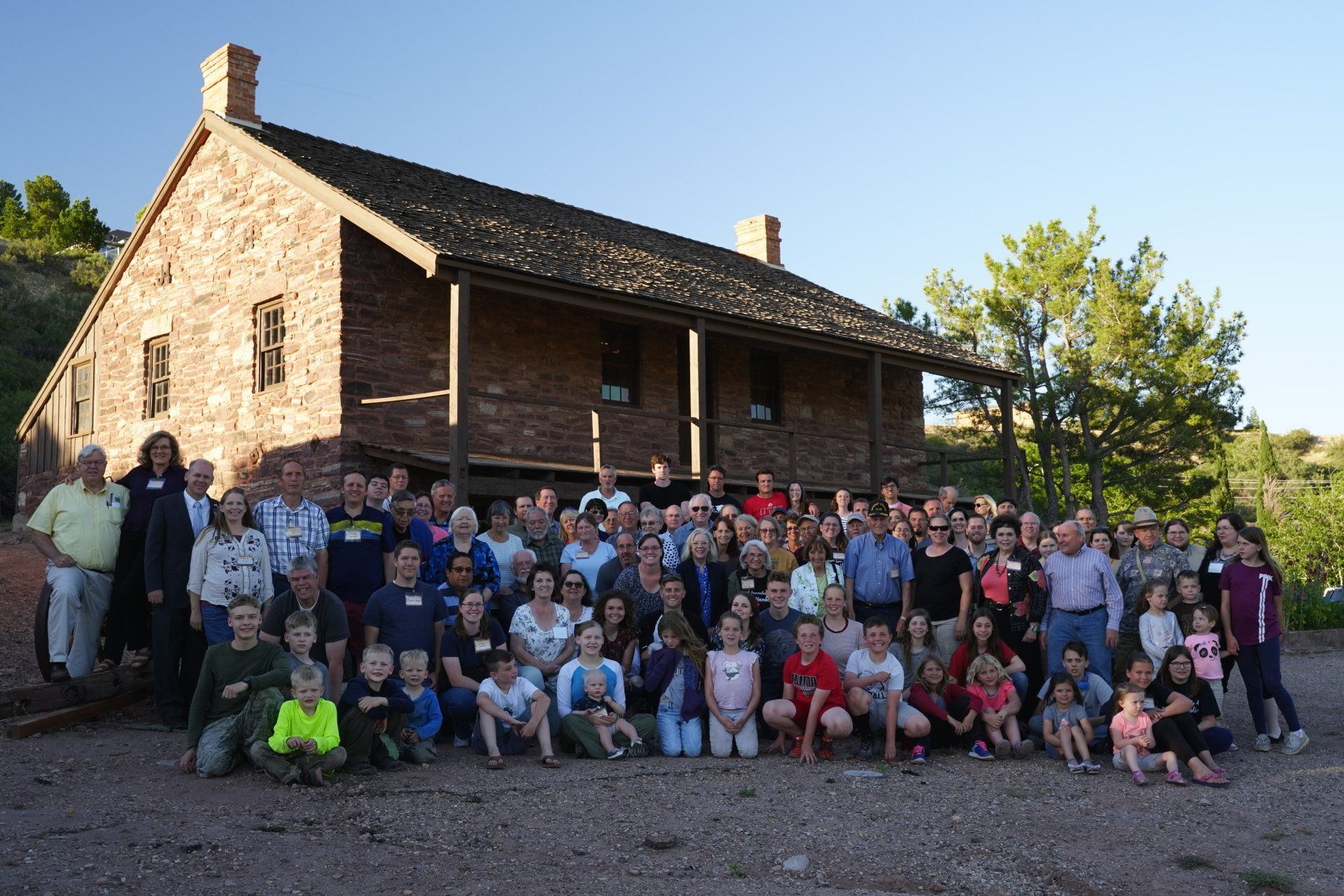William Stanton Hamblin
Donated by Joan Hamblin
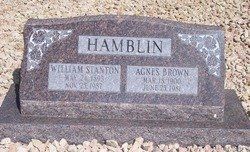
William Stanton Hamblin
May 24, 1893 –
Written in 1977
Brandon, the silver dollar that you got for your 12th birthday was given to your grandfather from his father, William Stanton Hamblin. Your grandfather hopes you will treasure it as a symbol of courage and faith.
My name is William Stanton Hamblin, born of goodly parents in Eagar, Apache County, Arizon, on May 24, 1893, at the Lytle home. My father was Jacob Hamblin, Jr., born in Santa Clara, Utah, March 21, 1865. My mother was Sadie Cornelia Lytle, born at Panaca, Nevada, October 16, 1867. They were married in the St. George Temple in St. George, Utah.
Life at that time was real difficult and hard to stay alive and to make a living for many was a real challang (challenge) for Father and Mother, not just their own family, but father’s mother, brothers and sisters, they provided for. In my Father and Mother’s family there was (sic.) 14 children – 9 brothers and 5 sisters - Jacob Perry, Lucy Priscilla, Wilford Woodruff, William Stanton, Jeremiah Roland, John Arlington, Sadie Alma, Carl Maeser, Velora, Lawson Arlo, Mark Elbert, Tannie May, La Vern.
Our first home was at Nutrioso, Arizona about two miles north of the town, a two-room log house. Father built a new home in town which is still in use, the Marion Lee home, built about 1895. I was a sickly child. Mother said she carried me in her arms most of the time, thinking I could not live much longer. Sometimes we do not always know (because) I am still around. They fed me on goat’s milk or anything they could me to eat and that was not very much because at that time, there was not very much to have, just what we could raise and find from Mother Nature, or we went without and that was quite often. Bread, milk, and gravy was (sic.) what we were raised on and we were lucky to have that.
My first memories as a child was (sic.) when I was three years old. My brother Roland came along about that time, pushing me out as the baby. Uncle Art Lytle was living at a ranch called Milligan between Eagar and Nutrioso, milking cows. He came over and got my brother Wilford and took him back to the ranch. I remember that I made such a fuss because I could not go. They locked me in a close (clothes) locker until I quit crying, then I would not come out. Father got me by the legs and dragged me in where Mother was.
I started to school at the age of six years. Maud Noble was my first teacher. I went to school dressed in a little checkered dress, made from an old tablecloth. And with long red curley hair. (Because) Mother had lost Jacob and Lucy, Mother said Lucy was a beautiful little girl and it was a real sorrow for Mother. I was kept as a little girl for a long time. I was small and rather puney most of the time, so I got a lot of attention from the family and from my teacher, Miss Noble. Some of the children felt like I was the teacher’s pet, and I guess that I was. She always called me her little boy friend so some of the boys nicknamed me, calling me little Maud, which followed me all the days of my life.
One day while at school I became very sleepy and Miss Noble sent me to play, but I went out and went to sleep by a red ant bed. The ants got all over me. I was so badly stung that I was not able to go back to school for several days. Mother said that I just about died.
One Sunday, my friend Drew Maxwell, who was my age, came over to the house while the rest of the family had gone to church. We found some matches and went out to make a fire. We had a large straw stack which the cows had eaten a hole back in the stack, so we got back in the hole, thinking noone would see us. We made us a little fire, but it soon became a big fire. We tried to get out but it was too hot. We started to cry and calling for someone to help us. Uncle Dudley Hamblin was coming out of church and seeing the smoke ran over to see what was wrong. He took off his new Sunday coat and beat the fire out and then got us out of the hot hole. His coat was a piece of roasted wool. Everybody was there by the time we got out and they all agreed that it was better to have a roasted coat than two roasted little boys.
Well, I was still in my checkered dress. One day, Mother needed something from a little store owned by Bro. William Pace. They had a dog that ran out and nipped me on the leg. I guess that I cred some, so Brother Pace took me in his little store, bought me a shirt and overalls and then cut my hair; he wrapped my long hair in my dress and sent me home. Mother would look at me and then cry. She kept those red curls until she died… we found them in her trunk.
Mother loved her family and tried hard to bring us up with high ideals to be decent and respectful. She would say to us quite often, “If you boys will neither drink or smoke, we will buy you a gold watch and chain when you are 21.” I think that it had some influence towards doing what was right, but they never had enough money to do the good wish that was in her heart, but I now wear a gold watch and chain and have for some 55 years, and I think of Mother’s desire to fulfill her promise many times when I look at the time.
While we lived in our first home, father took his mother back to Utah, leaving Mother and her children alone. It was a hard winter and father was gone for three months. We ran out of food, the snow was deep and no way to travel, only by horse. Uncle Will Lytle was living with us; he was just a small boy. Mother put him on a horse and with a letter to the Bishop asking for help, but the bishop refused to help her, saying to Uncle Will that he was looking after his own family and Jacob Hamblin should take care of his without asking someone else to take care of them. Well, Mother was desperate, her children was (sic.) starving. She prayed for help, then she thought of a man that was not a bishop and holding no part in the ward. He was considered a man of worldly ways. His name was Benjaman Brown; he was an uncle to Hugh B. Brown, so she sent her Brother Will with the same letter, pleading for some food and help. When Will came back, he had a large sack of flour, a slab of bacon, and a ham. Mother gave thanks to the Lord for answering her prayer. So what does it prophet (sic) a man if he has not charity? (So Benjamin Brown was a true Christian and a saint with mother. He was an Uncle to Hugh B. Brown.)
About that time, Mother took my brothers, Wilford and myself out in the pasture to fix a fence where some cattle had broken it down and was in our field. Mother tried to drive them out. There was a wild bull in the herd and was coming toward us. We tried to run but Mother kenw that it was a dangerous situation. She looked for some kind of protection. The rain had washed out a small ditch about three feet deep. Mother got us in the ditch, the Bull came over where we were, then pawed the ground and belloered a few times and then went back to the herd. I do not rember (sic.) how long we had to stay there, but I think we might of (sic) dug the ditch three feet deeper.
The first day of June was always a big day for country people and we young people always looked forward for the big events. Everybody that could go took their families (and) went out in the timber with big trees, made swings, played games and then a big dinner. For our last helping would be a jelley (sic) cake. The jelley (sic) was made from wild grapes and I think that it was the best cake that was ever made!
Most everybody had a(n) outhouse for a toilet. Some have had a three-holer, one for Mom, one for Father, and one for the little ones. While we were about ready to leave for the woods, there was (sic) three young ladies (who) went into the toilet. The door had a lock on the outside. My friend, Drew, saw the girls go in and we thought it would be real funny to lock them in, so we did. During the dinner hour, the girls were missed and someone went to look for them, they had been in the toilet about three hours. Well, the girls told on us and Live Brown (Eagar) caught us and I thought she was going to kill us, but I guess it was not more than we deserved but I thought it was at that time.
I was now in my 3rd year of school. At Christmas time, my cousin Ben Tenney and myself received a little slate in a red frame. I think that it was the best Christmas gift that either of us had ever received. Our Christmas was about four lumps of candy, 2 walnuts, either one apple or orange, 4 or 5 chalkey marbles. If we got a glass marble that was something wonderful. After Christmas, we were back in school. All classes held in one room. Each class would go up to the frunt (sic) for their lesson. This year, we had a new teacher, W.D. Rencher. He was real hard and crankey with the school (I thought so). One day, Ben and myself was doing something that mr. Rencher did not like. He came down to our desk and we had something on our slate that he did not approve off (sic.) I do not remember what it was, but he grabed (sic) both slates, broke them over our heads, leaving the frame around our necks, well, from then on I never had very much love for Mr. Rencher. Father ran the school, so Mr. Rencher did not come back the next year. (He was a good teacher for adults but not for the younger grades.)
About this time, as a little boy, I seemed to get into a lot of truble (sic), which I got paddled for. One day, I saw a man coming down the road in a one-horse cart. I hid under a bridge that he would come over, when he got to the crossing, I jumped out and threw my hat (at) the horse. Well, I gave him a good scare and he ran away. I thought it was real fun. Well, the man got his horse stoped (sic) and came back where I was, but I hid under the bridge. When he told me to come out, I knew that it was my Dad. I beged (sic) him not to hit me, I said, “Pa, if I had known it was you, I would not (have) scared your horse,” and that seemed to make it worse, and I got a good padeling (sic). At least Dad thought so, but I didn’t.
My sister Alma was the baby about one year old, when she sat down on a needle, went quite deep in her little seater. We tried to pull it out, broak (sic) it off. I held her with her little butty up so Mother could get hold of it with her teeth and got it out. Mother was sick and we did not have much to eat, some of the boys was (sic) going fishing and I wanted to go but did not have any hooks. Mother made me one out of a safety pin and I used a string for my line. The stream was small. I brought home three small trout. I do not remember wether (sic) I caught them with the hook, or got them wilth my bucket which I would use sometimes to catch the little minoes (sic) that was (sic) in the stream. Mother would say many years after that nothing ever tasted quite so good as those fish. (Well, that started me out to be a fisherman, now I am 84 years old and I am still trying to catch fish.).
At that time we had no doctors and everybody used what little knowledge and homemade remedy for medicine and cures. Someone had killed a small skunk which did not smell. Father skined (sic) it and Mother baked it for the oil that they would mix it with laudman and use it for earache. Mother had taken the skunk out and lifted it out on the porch in a pan. Uncle Dudley came in from the back and said, “Sadie, I hope you will not be mad at me, I have eaten most of that rabbit, and it was really good.”
I was baptized by Orson Wilkins in a mud hole and confirmed by my father.)
Father and Mother sold their property in Nutrioso and moved to Eagar. Our first home was a two large rooms log house; we only lived there a short time when Father built a new home. We lived there for about three years. Father had bought a farm so he sold our home to Will Eagar and built another home, which my brother Roland in later years bought and remodeled and is now living in it.
I was now 12 years old, real small for my age, and was always getting into trouble. Some of the older boys (in)formed me it was snowing that day and everybody was throwing snowballs. Someone said when the teacher comes out to ring the bell, we will all snowball him. I was for it in a big way, we made our snowballs and waited when he came out I wanted to be the first one to throw and then run. Well, I was the only one that threw. I hit him on the side of the head and knocked his glasses off. Well, nobody ran, and I was the bad boy. Well, school days were whipping days for wrong doings.
We raised our beans and ate a lot of them, and they had a lot of poopers in them. My friend, David Nelson, was three years older than I was. He had a girlfriend sit one seat ahead of him. One day my beans got to working and I had a pop-off. Well, I did not know what to do, so turned around, looked at David, and laughed at him. The teacher went down where he was, grabed (sic) him by the arm and said, “Young man, if you do that again, I will goifer (?) you.” His girl friend thought it was him (sic). Well, I knew what was going to happen after school, I got out first and ran, but not fast enough, Dave caught me and rubed (sic) my nose in the dirt. Well, I got a skined (sic) nose, and he lost his girl.
We had a small 20 (gauge) gun. I went hunting rabits (sic) one day. I got over in Mr. Hulsey’s field, the weeds were high and a big dog came running through the weeds. So I took a shot at him. I did not kill him, but he ran to the house yelping. Mr. Hulsey came out with his big gun and began to shoot. I thought he was shooting at me. He was not but I did not know it. I started to run and kept on runing (sic) until I got about one mile from the Hulsey farm and hid in a big wash and waited until dark before I dared to go home. But I never went hunting in the Hulsey’s field again. I guess that I was rather dumb and that I could never learn to keep out of truble (sic). One night the mail was late, we were all standing around waiting. We built a fire. Geo. Jarvis was there and told us that the old mail horses was (sic) scared of fire and they would really run and we wanted some fun or excitement. The mail came in; a poor old Mexican was the driver. Some of us threw sticks of fire at the horses, and my stick hit the old man on the neck. He began to holler, calling the postmaster, Mr. DeWitt. He came out but we had gone. I stayed out about all night, was afraid to go home. Sometime had passed and Mr. De Witt Alleck asked me about it and I told him what had happened. A few nights after that, we got into Mr. De Witt’s orchard to borrow some apples, I had filled my pockets and was crawling under the fence. Bro. DeWitt was there waiting for me. He handed me two more big apples and said, “Here, Stan, is a few more that you might need.” Well, I never stole any more apples from Mr. De Witt, and became one of my best friends. He moved to California. (Many years after that, he came back to visit. He told his son that Stan Hamblin was one to see.)
After school, one spring when I was 14 years old, I went to heard (sic) sheep for Mr. John Brown. We had 2 heards (sic). Charley Maxwell took care of the camp and was the cook. It was the month of May but we had snow and it was cold. Our camp was near the Ren Crosby Ranch, the head of Black River, just east of Big Lake. I had a mule to ride. At night, I would put my sheep in a corral, light some lanterns to keep the wild beasts away and then rid (sic) to camp. One night as I was saddling my mule, he broke away from me and ran. I followed him until dark. He went down a canyon. There was a long rope around his neck. He stopped by a big pine tree and I crawled up behind some logs and got hold of the rope, so after that I tried to be smarter than the mule. I tied him up before I put the saddle on. My brother, Maeser, and sister Alma was (sic) sick with scarlet fever. They came and took me back home. They were very sick and Maeser died. He was a boy in every way… healthy, good looking, well built and an athlete in many ways. It was very hard for Mother to give him up. She prayed for days asking the Lord to spare his life. One night while she was praying, she was given the feeling or impression that if Maesar lived, she would have a greater sorrow. His legs and arms were twisted and his brain had been injured with the fever. After that, she felt that the Lord had herd (sic) her prayers and was consoled with his passing.
I was paid for my work for hearding (sic.) sheep and I bought a cow and calf from Doctor Rudd. I had eight head of stock. Father never said anything to me about selling my cows and he let Uncle Waren Tenney have them and he never paid for them. Mother was very much upset over the deal and told Father that he would never get paid. Father would trust anybody, sighn (signing) notes which he would have to pay, and would give them anything he had if some would ask for it and people took advantage of generosity and on his death bed, he told me that he had to live a life time to find out that lot of things that he thought was (sic.) charity was (sic) nothing but ignorance and lack of judgement.
I was hit on the leg with a rake, leaving a bad cut. I did not take care of it. I got wet and the dye from my overalls got into the soar (sic.) and got blood poison in my leg. Mother and Grandmother Lytle used every home remedy they could think of, but I was real sick and was in a lot of pain. They became very frightened and worried. They put me in a buckboard wagon and took me to St. Johns. Grandmother Lytle came along trying to comfort or give me what help she could. A Doctor Platt was in St. Johns at that time. After looking me over, he said, “If you want the boy to live, his leg will have to come off,” but Grandma said, “No, if you take his leg off, he will die anyway, so we are going to bury him. He will have both legs on.” So they took me back home in Eagar doing everything that they thought might help me and nursed me back to health, and I have always thought the prayers and faith that Mother had that I might live with Grandmother’s love and care for me is one reason that I am still living and walking on two legs.
That summer after I was around and was back to normal, I got in a fight with Vernon Hamblin. I was getting the best of the fight and he set his dog on me. The dog got me by the leg and tore a big hole in the calf of my leg so I was sick with a bad leg for a long time, and I still have the scar from the bite. (Later on I got a chance to shoot the dog, and I did just that.)
Dad had bought a ranch in Greer in the spring before school was out. Dad took me to Greer and I was to carry the mail from Greer to Springerville and back the same day. I stayed at the ranch that Spring alone and I was afraid every night. A cow had died in the field not very far from the house. A big black bear would come almost every night and eat on the cow. I had a dog with me that stayed under the house. I always knew when the bear was around, the dog would bark and would go down where the bear was, and then the bear would chase the dog to the house. One night the dog was not fast enough to get under the house. He jumped on the porch and ran against the door, it came open, well, I might not be very fast, but I was fast enough to get the door shut before the bear came in. After that, I would put a nail in the door and put every thing that I could against the door. Sometimes when the moon was shining bright I could watch out of the window and see the bear and the dog going around and around.
Every other day was mail day, and one day I wanted to take a short cut and not go around the road. I knew of a trail that went down a steep canyon that we could go down during the summer when the weather was good. We had a lot of snow and the wind had blown over the bluff into the canyon causing large and deep snowdrifts. The weather had been cold, and there was a hard frozen crust on the snow. Not knowing the danger and risk I was taking, I got my horse out on the snow. The drift was steep, running down to the botom (sic) of the canyon. My horse stumbled and fell on the snow. I tried to get back but it was too late, we started to slide, roll and tumble until we got to the bottom, it must have been 400 to 500 feet from the top to the bottom. That was the reason we did not break through (the snow) (because) the horse was never able to get on his feet, he stayed on his side all the way down. I gathered things up and went on. I had to cross the river. I rode into the stream and water washed me from my horse. I could not swim but I managed to grab hold of a willow and got out. My horse had gone down the road without me. A Thompson boy saw the horse and he knew that something was wrong. He caught the horse and came back, about three miles before he found me. I was afraid to tell Dad, but I had lost some mail in the river that belonged to Mr. Cambell who lived on the river so he went to Mr. Becker who was the past Master about his mail. Father came up to Greer to see just what had happened. Mr. Cambell had told him that the trail was full of snow and he did not know how the kid got to the river. Father went down to see just what did happen. That drift was more than 100 feet deep covering some of the tall pine trees. It frightened Dad so bad that he forbade me to go there again until the snow was gone. Well, he did not have to tell me, because I relized (sic) if we had broken the crust we would have been there until Spring.
The family moved to Greer that Spring. We farmed, milked cows and made butter and cheese. I was the cheese maker. We would milk the cows at night and then in the morning strain the milk into a big wash tub, but we had to have the milk up to a certin (sic) temperature and put a white tablet they called rennut which would cause the milk to curdel (sic) or clabber. Mother would tell me what to do. She would put in salt and collaring (coloring?), and then I would do the rest. We would dip all the water or whey off, leaving what we called curd, then pour hot water over the curd, drain that off, then chop it quite fine, put it in a sack called cheese cloth, then put it in a wooden cog (?), put pressure on, to squse (squeeze) what water or whey might be left, and leave it to cure. This was done every day, six times a week, until we had enough for the winter.
That summer, we had a lot of chipmunks that would eat about everything and was (sic) a real pest. They lived in holes in rocks and trees. They would travel from the trees on our pole fence to our field and garden. We had a lot of fun trying to get rid of them. We would watch and when we would see them runing (sic) along the fence we would call the dog. Some of us would run down to one end of the fence and some to the other. They would stay on the fence trying to go back, and as the chipmunks came along we would knock them from the fence with a long stick. We killed a lot of them that way.
One day, father was out helping us. He got excited and was having fun with us. My brother Roland knocked a chipmunk towards Dad but did not kill it. It ran up Father’s pants leg; you would of (sic) thought a big bear was after him. He graved (sic) his pants where the chipmunk was and calling for help, we ran over where he was trying to get his pants off. We finally did. We shook his pants and found nothing but hamburger. Father had squeezed that little fellow so hard that it looked like it had been run through a meat grinder, and that was the last time Father tried to help us in killing the chipmunks.
I seemed to be the fisherman in the family, and it was part of our living. There was no limit at that time, and the streams and lakes was (sic.) full of fish. Quite often, I would take some of the fish with me when I took the mail and would sell them to a Mr. Holt who worked for Mr. Becker. He would give me 10 cents a pound and that was a lot of money, and the only money that I got from carrying the mail.
Father had a cousin Dewayne Hamblin. He was always saying what a good fisherman he was. One day, Father told him that he had a little redheaded freckled-faced kid to outfish him. Cousin Dewayne did not like it so Father bet him $25 (in the retelling of this story this became $100.). that I could outfish him. (That was a church bet which was never paid, win or lose), so the contest was on. The day was agreed on, the families got together and all went down on the river below the river reservoir for the big event and for a day of pleasure. And it was no laughing matter with Cousin Dewayne. He did not want a kid like me to be a better fisherman. The rules was (sic.) made, to start at the same time, stay close to each other and then stop at the same time. Cousin Dewayne had his two daughters, Wilmaith and Eva come along and count and carry the fish. Cousin Dewayne was a (sic) honorable man and wanted to play fair. He thought that we were even in numbers so he said, we will quit, but I guess that I was not quite as fair as Cousin Dewayne because I wanted to win and not let Dad down. At a bend in the stream, I had caught a fish that was not counted, and I put it in my pocket (the story later was told that Stan dropped it in his fishing boot) and not in my bag, so we went back to the camp and counted each bag. I had managed to put my extra fish in the bag with them not seeing me. When the fish was (sic) counted, I had one more than Cousin Dewayne. He laughed and said that your boy is not a better fisherman, he just outsmarted me. He was a good sport and many years after that he would talk about our little contest. He was a good man and a real friend to all of us.
It seemed like I was looking for fish whenever I had a chance. That Spring when we first moved to the ranch, I was walking along a filling ditch just above our house and I saw some big fish. I went back home and wanted Roland to go with me and maybe we could catch some of them. Roland had been sick and Mother did not want him to go with me, but she said, “Well, he can go, but if you get him wet, I will whip both of you.” We got some pitchforks and went down to the ditch and we worked until we got a real big fish in shallow water and then stuck it with the fork. It was one of the largest fish I have ever seen, a native trout, 24 inches long. We both got wet. I tied the fish on my belt behind me and we went home. Mother was really upset when we came in the house. I said, “Mother, I am sorry we got wet but could not help it. So I guess you will have to give me a whipin.” So I turned aroud, when she saw that fish, she was so excited that she forgot all about what she was going to do. I cleaned the fish and cut it up and the family had a big fish fry that night.
We always had a lot of things to do that we could enjoy ourselves. Life was never dull some time we would do things that Dad did not like and then life was not quite so bright. Father was gone most of the time, so it was up to Mother and we boys to run the ranch. Mother never did get very excited about things, so we were quite free when Dad was gone. We always had a lot of visitors. That was our social life, visiting each other. One night we had company, the wind was blowing hard, everybody talking and making a lot of noise. I had wind on my stomach and wanted to get rid of it. I opened the door, stuck my head out and pooped off, thinking that noone would hear me. I shut the door and said it was really blowing outside. Dad had heard me and he said, “Yes, my boy, it seems to be blowing inside, too.”
We moved back to Eagar that fall in time for school. I did not go to school that winter, I stayed out to plow, feed the cattle and sometimes carry the mail. One night, I went to a dance, I did not have a dance ticket so I stayed outside. The Church always had a dance manager, and he was sometimes called the breath smeller. Anyone that came in the dance hall that they thought might be drinking, they would smell their breath and if they smeled (sic.) whisky on them, they could not come in. Bro. Edman Nelson was at the door that night, when three men who had been drinking tried to go into the hall. Bro. Nelson tried to stop them, but he was no match for three of them. They got him outside and pulled his coat tail, pushing him from one side to the other, making fun, at least they thought so. Bro. Nelson had them arested (sic.) and brought them into court. I was called as a witness. Before they put me on the witness stand, the judge who was a Mr. Tony Long called out for me to come forward. He said, “Stone Hamblin.” I did not answer, he then said, “Stean Hamblin.” I still did not answer. “Stout Hamblin.” I still not answer. Mr. Long said, “What in hell is your name, anyway?” And everybody laughed. From then until now, I still have some of my friends call me one of the above names, Stean, Stone, or Stout. I guess I was about 14.
After testifying for Bro. Nelson, he thought I was his friend and I worked for him. Sometimes I stayed at his home that spring and carried mail from Eagar to Luna, New Mexico on horseback. I would go over one day and back the next. It was a hard trip about 50 miles each way, sometimes I would have mail stacked all over the horse that I could bearly (sic.) see out enough to ride. My lunch every day was a two large baking powder biscuits with a friend egg and a piinch of salt pork in each biscuit, but it realy (sic.) tasted good when I would stop and feed my horse and rest at noon. I would stay with Bro. and Sister Amasa Reynold, and we have always been good friends since that time.
My schooling was quite limited. Father and Mother always would say, you do not have good health and outdoor life is what you will need for a longer life. I do not remember graduating from the eighth grade. I was out of school so much that I just stopped going. When I was eighteen, I went to St. Johns Stake Academy, a church school, for three terms, but I was always from four to six weeks late in the fall, and then went back home a month before the school was out for the summer.
At this time, the draft was on for the Army. Wilford, Roland and John and I got my call. But I did not pass the exam. I always thought that I did, but somebody had to run the farm. I tried to volunteer and was turned down again. Well, I was not very large, I had to stand in the same place twice to make a shadow. I boasted 116 pounds when fully dressed with a few rocks in my pocket. We had a large farm and my father thought that I should know how to do everything, but I never did do many things that would please him. Well, that was the way I would feel at times, but maybe most children sometimes get in that mood.
We would plow with four horses, sometimes with two, but to plow 100 acres, it seemed like we was (sic) plowing all the time. Then plant it, mark it in small furrows, then to turn a small stream of water in each furrow so it would not wash was a job for an experienced man, but I tried, not because I wanted to, but I had to. When the grain was ripe, I would cut it with a grain binder that would cut it and bind it in small rolls, and then leave them on the ground. It took four big horses to pull this machine. After the grain was cut, we would gather the little bundles and put them in small stacks about 12 bundles to a stack, called shocks with the heads up. Then after the grain was dry we would load them on a wagon and haul them to a machine, called a thrasher, that would beat the grain out so the wheat or oats would run out of a small pipe into a sack, and the straw would go out another way to be stacked for feed for our cattle.
David K. Udall had the mail contract from Springerville to Holbrook. One day his mail driver was sick and he asked Father if I could go, I was only 15, but Father said I could go. It took four days to make the trip, two days down and two days back. We had a buckboard and two horses. Sometimes, just one horse and one horse cart. We would stock at Hunt, 30 miles north of St. Johns, camp for the night and then on to Holbrook. I had never seen a train. I went over to the RR depo (sic) to watch to see if one would come in. Sure enough, one was coming from the east and one from the west on different tracks, but I thought that they were on the same track, and I was sure they were going to crash. I got under a big box, and when I got out I was surprised to see them still going on the same track. Well, I went back with the mail for another trip. I went over to see the train again, this time it was a long freight train going along real slow. I wanted to ride on a train, so I grabed (sic.) onto the side of the train that had a lader (sic.) on the side. Well, it got to going quite fast, I was frightened and I knew that I had to get off as the train went around a curve, the grade was high so I let go and jumped off. I rolled, rolled, and rolled, but I did not get hurt.
Well, I carried mail, hearded (sic.) sheep, run the farm, but never did receive any money for it. However, I do remember Father giving me $1.00 for the 4th July. Father did not have a cash job and what little money we could get went for taxes and for family needs. He had his mother’s family and his to look after and he did good job in providing for so many.
Joseph Udall was our Bishop and our neighbor, and they were milking about six cows. They would turn them out on the streets and they were bad to break down or jump over fences. They kept getting in our field of grain. So one day, I drove them in our corral. I found five large five-gallon cans. I put some rocks in each can so they would rattle and then tied a can to each cow’s tail and then ran them out of the corral. Well, you can talk about the excitement it was! There half of the town turned out to see if the US Army had come to town. I was really having a good time, until I saw one of the Udall boys coming my way. He was four years older than I was. I ran, but it did not do me any good. I knew that I was going to get a beating, but he just set down on me and started to laugh. Then he said, “Well, Stan, do not do that again, but that was the best show that I have seen all summer.”
In the year 1812 and 1913, Father was building the Lyman dam, 12 miles south of St. Johns. He had gone on a bond for a Mr. Dave Rencher and WH Gibbons who had the contract to build the dam, but they failed and the state tried to collect the bond, but my father said, “I can not pay the bond, but I will build the dam.” And he did. He was able to pay all the bills and paid the men who had been working for Rencher and Gibbons.
I worked on the dam when I was not farming. I took care of the horses and helped in the cook shack some and kept time on the men. The dam was built with dirt hauled in on wagons about two yards to the wagonload. At first, we dug out a large deep ditch, then built a bridge over it so a team and wagon could drive under the bridge. The bridge had a hole in the top. The wagon was stopped under the hole. The men that was (sic.) driving and pulling a scraper called a fregno would fill it with dirt and then drive over the bridge and dump the dirt into the wagon. This was a very slow process so Father bought a machine called a loading grader. It took 20 had of horses to pull the machine, 16 in the front and four behind. It would plow the dirt and elevate it up so a wagon could be filled with the dirt from the elevator as they went along without stopping. Father was a good manager and he knew how to do things well and get along with the working men. However, I always felt that he was always on the other fellow’s side more than he was on his own. He was working about 100 men and he was carrying a heavy expense load so we could not have the work stop. A man by the name of John Hall was driving the grader with the 20 head of horses. He and Father were very good friends, but Hall was what they call a hot head. Father said something that he did not like. He jumped from the grader and said, “Jake, if you know so much, just run it yourself.” Father stood his ground. He sent someone after me. I went over to the grader and Dad said, “Stan, do you (think) you could drive that outfit?” I said, “Well I do not know, but I will try.”
Well, we got along very good and I thought I was a better driver of those twenty head of horses than John Hall ever was, and Father inflated my ego some by telling me that I wss a top hand. Well, you know that sometimes those good things do not always last, and if you alow (sic) your ego to become inflated too high, it might bust. Well, that was just what happened to me.
We had to get the dirt whereever we could. Father had cautioned me several times not to leave the grader in the hole where we were getting the dirt. Well, one day we had been working at the end of a dry wash, the hole was deep, we stoped (sic) for noon. We took the harness from the horses and left everything on the ground and went to dinner. Well, I could handle the grader and the horses well, and I knew that I could, but I forgot or neglected to remember Dad’s admonition and went off and left everything in the big deep hole. Well, while we were gone, a big rain storm came up and filled the hole covering the grader, wagons, harnesses and everything we had left when we went for dinner. And that was the last time we used the big grader. We spent sometime in diging (sic) a ditch to drain the water out of the hole. You could have called it a lake because in some places it was about 20 foot deep.
I guess that Dad thought that I was a better farmer than I was a dam builder. I was out of school that year and did not go back until the next school year. A Sister Wilbank that lived at Greer was runing (sic) a bording (sic) house for the school so I stayed there. It was the JT LeSuer home. He sold it to the church and moved to Mesa, Ariz. A man by the name of Sam Right had a barbershop just across the street. One day he was beating one of his boys, and I was standing by watching him. Well, I guess I was feeling sorry for the boy, and I said to Mr. Right, “You hit that boy again, we are going to beat you up.” He said, “You and who else?” I yelled at him and said, “Me, and all my friends here.” Well, he let the little boy go, but said nothing. About two weeks after that, I went into his shop for a hair cut. He took his clippers and cut a strip down through the center of my head and then said, “Stan, that makes us even.” He moved up into Utah but came back several times, and he would hunt me up if I was in town and would always tell me, “I have never whiped (sic) another child,” and would thank me for calling him some bad names, telling him what kind (of) a man he was. I do not remember just what I did say but I am sure that I was not a gentelman (sic) or a good Dad.
I was too small to take very much of a part in athletics, but did some long distant runing (sic). There was a contest being held at Snowflake, Arizona between St. Johns and Snowflake. Jess Lewis and myself wanted to run in the mile race but they thought that we were not good enough but said we could not be in the starting line but could run after the rest started. So we wanted to try. We got ahead of the other six that was runing (sic), but they underrated us. We kept getting farther ahead on each lap and on the last quarter mile they were quite sure that we did not count in the race and that we could not hold up at the rate we were runing (sic), but it was too late. So Jessie Lewis (2nd) and myself (1st) were first and second in the mile race. St. Johns won the contest and after we came home, the town was putting on a little celebration matching single men against the married men with various events. I was put in the ring with Judge A.S. Gibbons in a boxing contest. I don’t know why, unless I was always on the fight and would try most anyone that wanted to fight. Judge Gibbons was larger than I was, and I was somewhat afraid of him. I guess that I was not a very good sport, so I went after him with all that I had and broke his nose. It was never properly taken care of at that time and he always had a crooked nose after that. And I always felt that I was to blame.
During that time, if we wanted a little excitement or fun, if you might call it that, we had to stir (up) something ourselves, and fighting was one of the main events. And it was with your bare fists and no gloves and if a new boy came to town, he always had to prove himself in order to be excepted (sic) into the town boys. There was a boy by the name of Herbert Day that some of the boys thought that he was the best fighter and some of my friends thought that I was - at least they made us believe that we were. Well, Herbert and myself talked it over each thinking that we were the best, and so we agreed to go somewhere alone and try to see which one was the best. Well, we did just that and after we had pounded on each other, we stoped (sic) to rest, and decided that we were not getting any fun out of the fight, so we agreed to call it an even fight and went home.
I weighed 116 pounds when I was married.
(This is the end of this account of his life by Stan Hamblin. Later on, he shared with his family some other stories that are recorded elsewhere. Agnes wrote the following events and dates.)
William Stanton Hamblin
William Stanton Hamblin was born on 24th May 1893 in Eagar, Apache County, Arizona.
His mother’s name was Sasdie Cornelia Lytle, born on 10th of October, 1866 in Panaca, Nevada. Her mother’s name was Lucy Clarinda Atchison Lytle and her father was William Perry Lytle.
His father’s name was Jacob Hamblin, born 21st (22nd?) March, 1865 at Santa Clara, Utah. His father was Jacob Vernon Hamblin.
William Stanton Hamblin was blessed by L.J. Brown 3rd of August 1893.
Baptized by brother Orson Wilkins 7 July 1901.
Confirmed by his father, Jacob Hamblin Jr.
(Editor’s note: sic. means that even thought there was a grammatical error or spelling error in the original, it was left as it was in the copy.)
